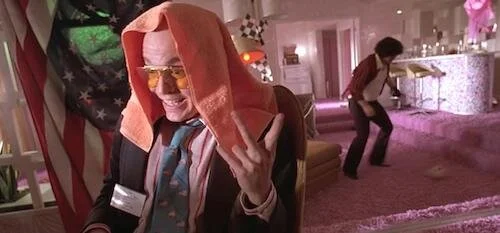Fear and Loathing in Las Vegas: On-This-Day Thursday
Every Thursday, an older film released on this opening weekend years ago will be reviewed. They can be classics, or simply popular films that happened to be released to the world on the same date.
For May 22nd, we are going to have a look at Fear and Loathing in Las Vegas
Toss Fear and Loathing in Las Vegas in the pile of films that teenage me considered to be philosophical works of genius that I have seen through once I graduated with a Bachelors degree. I’m quite torn on this film. On one hand, I would argue that Fear and Loathing in Las Vegas continues to make me laugh harder than most films ever have. The insane antics of Hunter S. Thompson — ahem, i mean Raoul Duke — played by Johnny Depp are priceless, particularly because of his froggy grimace and his intense mumbling to get through his cigarette holder blocking the airway through his clenched teeth. I will forever have a love for lines like “Let’s get down to brass tacks. How much for the ape?” and “I need this, right?” in relation to a valet ticket stub, as well as the insane sequences where Duke launches a fruit at his attorney Dr. Gonzo while he is trying to commit suicide in a bathtub. Then, there’s the climactic adrenochrome trip, which is exactly what everyone paid to see after looking at the warped film poster.
Having said all of that, my fondness for the silliness in the film — perhaps strengthened by director Terry Gilliam’s knack for the unusual in a comedic sense — is quickly stifled by whatever coherence or meaning the film is supposed to have. Hunter S. Thompson’s novel was a superb apology to both Sports Illustrated and Rolling Stone for his counterculture stance during a time where Thompson believed that very movement was a let down in the grand scheme of America. This roman à clef, or piece of gonzo journalism, felt like Thompson’s means of explaining why he didn’t get the scoop he was assigned to (not in the way that was intended, anyway) with a fantastical story, blending the real excuse with hyperbolic stories, creating a piece of journalism that channeled only Thompson’s “facts”. To me, the film neglects to contain any of this poignancy, despite its best efforts. With introspective moments where Duke thinks to himself about America’s changing times, the film hits a lull, which is quickly reverted to more zany antics. There is absolutely no balance between the highs and the lows.
Raoul Duke and “Dr. Gonzo” tripping out on adrenochrome.
Sure, it can be funny to see people stoned out of their minds, but the commentary the film tries to make turns into babble. If it’s not incoherent, it’s dull to listen to. Fear and Loathing isn’t exactly like listening to your high friend not make any sense, but it shares the same sort of annoyance that seeps in once the amusement wares off. The types of works Thompson was discussing were like Easy Rider, which went fully into the unknown without zero cares. Fear and Loathing tries to be anarchistic, but with a point. It simply doesn’t work. Had the film been a completely chaotic miasma, then maybe it would have something to say in how the film is represented and not what it’s explicitly saying. Either that, or go the opposite way and be profound. I’ll give you an example of a good balance. In something like Dazed and Confused, where you are listening to high schoolers try and be the voices of their generation whilst drunk and stoned, there are still limits that give the film a definable charm. No one is trying to solve the shifting tides of America, and we’re not in the heads of these kids for an entire film; that’s also important, as some films may feature scenes of stoner thoughts, not entire features.
Besides, Fear and Loathing in Las Vegas was released in 1998. It’s not exactly rebelling against anything in the film industry, unless you consider the sanitized Awards season during this decade; even then, Gilliam wanted this film to be purposefully polarizing, so it’s not like it was meant to win awards for the now. No. Fear and Loathing was meant to have a legacy. Gilliam has said so himself. Outside of its pop culture status, I don’t know so much about this twenty two years later. When I think of films that successfully countered culture and have staying power, I imagine Bonnie and Clyde, or Midnight Cowboy, which had so much to say in how the film was made. Fear and Loathing in Las Vegas mixes a story, barked messages, and absurd drug episodes all in one. Yes. Teenage me believed the film when it had something to say. Now, having seen many films that have made statements better (and better statements), that would be the last reason why I would watch it. Slicing this film up into its various episodes ruins its pacing, and renders the film beyond choppy. I certainly have favourite moments that still make me laugh. I’d hardly call this a favourite film.
Andreas Babiolakis has a Masters degree in Film and Photography Preservation and Collections Management from Ryerson University, as well as a Bachelors degree in Cinema Studies from York University. His favourite times of year are the Criterion Collection flash sales and the annual Toronto International Film Festival.






